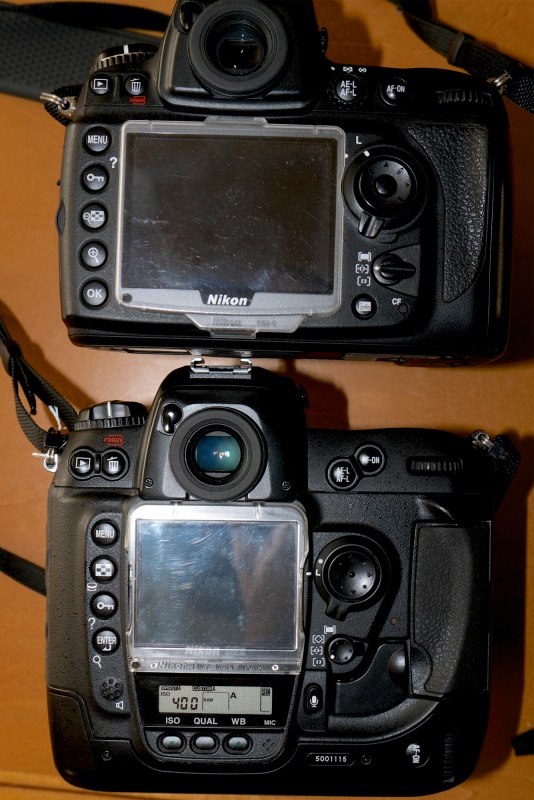Thank you, Nikon.
One of the welcome features of the D2X (2005) is how little its design varies from the much more recent D700 (2008):

Top view – each camera has a GPS data receiver installed top left, the D2X’s safety tethered with dental floss ….
The top plate controls are almost identical except for the aperture/shutter Lock button on the D2X, lower left, for which I have yet to divine a serious use, and the superior metering selector on the D2X’s prism, which has an invaluable lock button to prevent accidental movement. The one on the D700 is just visible here on the rear plate and is prone to accidental change. The ISO button on the D2X moved to the lower rear. The D700 adds a handy pop up flash. The D2X has none.
The rear views are also similar:

The 3″ screen on the D700 dwarfs the 2.5″ LCD on the D2X.
Of note is that one button has been added for minus magnification on the D700 (top) replacing the two button action needed on the D2X, An improvement for those into LCD chimping, a practice I avoid as much as I do politics. Note the Nikon DK-17M magnifying eyepieces I have fitted to both bodies – a massive improvement over stock and a must-have for anyone using manual focus lenses. With these fitted both finders show a huge, clear, uncluttered image, wonderful for composition and shooting.
The D2X adds the lower information panel common to all the D-Pro bodies and most definitely not an improvement as the text is small, for the most part, and hard to read. All of this information falls nicely to the top display in the D700. Finally, in addition to the large battery grip which permits easy vertical shooting, the D2X adds a microphone and speaker activated by the button to the lower right corner of the LCD display for recording voice memos of up to 60 seconds for each snap. Very handy. The D2X hides its CF card behind the door to the right of the LCD and adopts a truly complex access mechanism which will have you resorting to four letter words when it comes time to replace the card. The D700 adopts a far superior sliding latched door on the right of the camera. Finally the center button in the four way rocker dial for changing focus points is far superior on the D700 to the one on the D2X. It protrudes a millimeter or two further, making engagement on a center press much easier. With the D2X you find yourself toggling instead of pressing, as often as not. I suspect that a small piece of rubber glues to the D2X’s button will fix what ails the design. The AE-L/AF-L and AE-ON buttons at top right are identical on the two bodies.
The front plates are identical. What the above snaps cannot disclose is the extent to which the software is much the same between the two bodies and that is the icing on the cake. It adds to an easy ergonomic learning curve the absence of torture-by-software which every new DSLR imposes on a new user. So for D700 owners thinking of upgrading to a pro body – D2X, D3, D4 – they will likely find as I did that they will be up and running in no time.
The D2X is faster in most respects. It can sustain an 8 fps framing rate in cropped mode using the stock battery; to accomplish that with the D700 requires the battery grip and new batteries, as the stock will not fit. Mercifully, regular AA cells are an option to the costly Nikon LiOn battery. Shutter response of the D2X is marginally better, but in practice the difference makes no matter. What is noticeable is how much quieter the D2X’s shutter is. Maybe that’s because it’s smaller given the smaller frame and maybe it’s also because the D2X’s flapping mirror is smaller for the APS-C format. Whatever the reason, the result is clearly distinguishable. Batteries in the D2X are inserted from the side, those in the D700 from below, meaning that if used on a tripod, the change in the D700 is more fiddly. However, both bodies have such high battery lives (probably over 800 shots on a charge) that the practical inconvenience with the D700 is not significant.
For MF lens users the focus confirmation light in the D2X is better than the one in the D700, shuddering less at the point of optimum focus. Nikon has long spec’d its pro and prosumer AF modules as requiring an aperture of f/5.6 or faster, but I have found no difficulty in using the AF confirmation light in the D700 with the f/8 Mirror Reflex Nikkor. On the D2X that light fails, making confirmation focus with the D2X impossible. A shame.